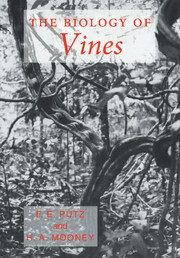Book contents
- Frontmatter
- Contents
- List of contributors
- Foreword
- Preface
- Acknowledgements
- I INTRODUCTION
- II CLIMBING MECHANICS AND STEM FORM
- 2 Anatomy of vine and liana stems: a review and synthesis
- 3 Biomechanical studies of vines
- 4 Structural responses to stem injury in vines
- III VINE PHYSIOLOGY AND DEVELOPMENT
- IV COMMUNITY ECOLOGY OF VINES
- V ECONOMIC IMPORTANCE OF VINES
- Taxonomic index
- General index
4 - Structural responses to stem injury in vines
Published online by Cambridge University Press: 05 November 2011
- Frontmatter
- Contents
- List of contributors
- Foreword
- Preface
- Acknowledgements
- I INTRODUCTION
- II CLIMBING MECHANICS AND STEM FORM
- 2 Anatomy of vine and liana stems: a review and synthesis
- 3 Biomechanical studies of vines
- 4 Structural responses to stem injury in vines
- III VINE PHYSIOLOGY AND DEVELOPMENT
- IV COMMUNITY ECOLOGY OF VINES
- V ECONOMIC IMPORTANCE OF VINES
- Taxonomic index
- General index
Summary
Introduction
The stems of vines have a relatively small cross-sectional area in relation to the leaf area supplied by the stem compared with more typical herbaceous and woody plants. Non-climbing plants are self-supporting and, therefore, much of the stem tissue must serve a mechanical, non-conducting function. This relationship is discussed in detail by Ewers, Fisher & Fichtner (Chapter 5). Because a given area of sap wood and phloem supply a large leaf area in a vine, we assume that injury to a given area of a cylindrical stem surface or are on a stem's circumference will have greater potential impact on the leaf area of the shoot than would an injury of similar size on a tree, shrub, or herb. We will consider several types of stem injury that a plant can experience in nature due to physical abrasion with itself or other objects, damage by animals, bending or twisting in wind or during limb and tree falls, and complete breakage during tree falls. Surface damage to the bark, including the functional inner secondary phloem and the vascular cambium, would interrupt the normal movement of organic compounds in the phloem and the production of new xylem and phloem. An encircling injury or bark girdle would completely disrupt these functions in a typical stem with a cylindrical vascular cambium. Stem twisting and bending can result in partial splitting of the stem or complete breakage.
- Type
- Chapter
- Information
- The Biology of Vines , pp. 99 - 124Publisher: Cambridge University PressPrint publication year: 1992
- 7
- Cited by



